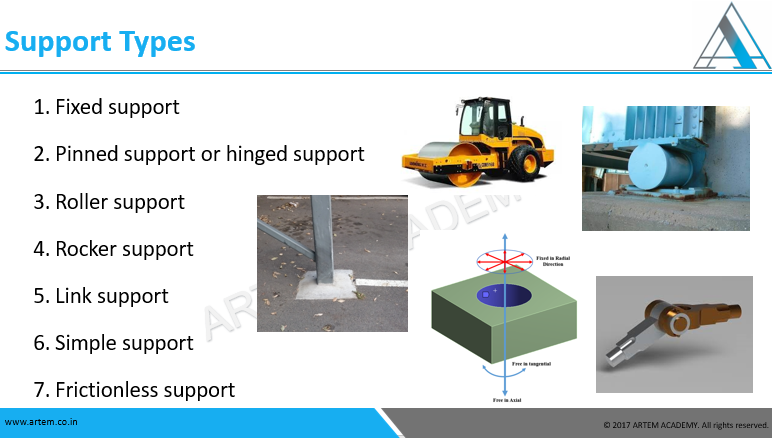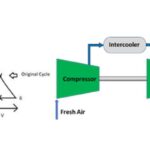

Types Of Supports
Supports are arguably one of the most important aspects of a structure, as it specifies how the forces within the structure are transferred to the ground. This knowledge is required before solving the model, as it tells us what the boundary conditions are. Supports are a crucial part of your structural analysis model. You must understand the different types of supports from the beginning as they have the potential to incorrectly represent your model. This can cause incorrect results that do not accurately simulate a real-life situation. Here, the aim is to explain the different types of supports as well as their real-life examples along with their allowable reactions.
In general, various material structures are connected in different ways according to the functionality of the system. Structural steel systems have either welded or bolted connections. Precast reinforced concrete systems can be mechanically connected in many ways, while cast-in-place systems normally have monolithic connections. Timber systems are connected by nails, bolts, glue, or by engineered connectors. No matter the material, the connection must be designed to have a specific rigidity. Rigid, stiff, or fixed connections lie at one extreme limit of this range, and hinged or pinned connections bound the other. Connections in any system are also called supports or constraints.
The supports which are usually provided externally without disturbing the structural members are external supports. Different types of external support are as follows:
- Fixed support
- Pinned support or hinged support
- Roller support
- Rocker support
- Link support
- Simple support
- Frictionless support
- Fixed Support
The fixed support is also called rigid support. It is a support that is capable of resisting all types of loads i.e., horizontal, vertical as well as moments. In simple words, the fixed support does not allow the rotation and translation motion to the structural members. It provides greater stability to the structure as compared with all other supports. To provide good stability to the structure, at least one rigid support should be provided. Beam fixed in the wall is a good example of fixed support. Beam fixed in the wall is a good example of fixed support as shown in fig 2. The other examples of fixed support are electric poles in the streets, a bracket on the wall, and all the riveted and welded joints in the steel, etc. The reactions acting in the fixed support are shown in figure 1 given.

- Hinged Support
The hinged support is also called pinned support. The pinned support has two support reactions and these are vertical and horizontal reactions. It allows the structural member to rotate but does not allow translating in any direction. The horizontal and vertical components of the reaction can be determined using the equation of equilibrium. The reactions of the pinned support are shown in figure 3. The best example of hinged support is the door leaf which only rotates about its vertical axis without any horizontal or vertical movement as in fig 4. In the human body, the knee is the best example of hinged support as it allows rotation in only one direction and resists lateral movements. Hinge support reduces sensitivity to an earthquake.

- Roller Support:
It is a support that is free to rotate and translate along the surface on which they rest. The surface on which the roller supports are installed may be horizontal, vertical, and inclined to any angle. They resist only vertical loads. The roller supports has only one reaction, this reaction acts perpendicular to the surface and away from it. The reaction offered by the roller support is shown in figure 5. In other words, the roller supports are unable to resist the lateral loads (the lateral loads are the live loads whose main components are horizontal forces). The best example of roller support is the roller skates as in fig 6 along with some other common applications. The roller skates resist the vertical loads of the persons standing on them. When the lateral loads are applied by the persons, then it starts translating. The translation is due to its inability to resist the lateral loads.

- Rocker support:
Rocker support is similar to roller support. It also resists vertical force and allows horizontal translation and rotation as in fig 7. But in this case, horizontal movement is due to the curved surface provided at the bottom as shown below figure. So, the amount of horizontal movement is limited in this case as shown in fig 7.

- Link support
A link has two hinges, one at each end. The link is supported and allows rotation and translation perpendicular to the direction of the link only. It does not allow translation in the direction of the link. It has a single linear resultant force component in the direction of the link which can be resolved into vertical and horizontal components. In other words, the reaction force of a link is in the direction of the link, along its longitudinal axis. The support and the reactions to the link constraint are shown in figure 8. The best example of link support is pliers and in most locomotives, it is used to connect the parts as shown in figure 8.

- Simple supports
Simple support is just support on which a structural member rests on an external structure. They cannot resist lateral movement and moment like roller supports. They only resist vertical movement of support with the help of gravity. The horizontal or lateral movement allowed is up to a limited extent and after that, the structure loses its support. It’s just like a brick resting longitudinally on two bricks. Another example is a plank of wood resting on two concrete blocks. Simple supports aren’t widely used in real-life structures. The simple support and the reactions that we get in the type of support are shown in the figure.

- Frictionless Support:
It is a type of support used to constrain degrees of freedom in normal directions. This support or boundary condition is used to prevent one or more flat or curved faces from moving or deforming in the normal direction as shown in fig 10. If this boundary condition is applied to the face of the body, then no portion of the surface body can move, rotate, or deform normal to the face, but for tangential directions, the surface body is free to move, rotate, and deform tangentially to the face. If this support is used for a flat surface body or solid body, then it is equivalent to the mirror symmetry condition as in fig10.



